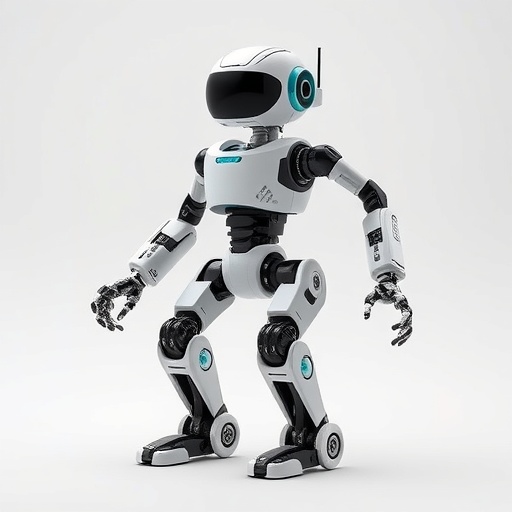In a groundbreaking leap for robotics and artificial intelligence, researchers have unveiled a revolutionary class of multi-modal flexible electronic robots imbued with programmable sensing, actuating, and self-learning capabilities. This pioneering work, documented in Nature Communications, marks a significant milestone in the convergence of flexible electronics, embodied AI, and adaptive robotics, promising innovations that could transform sectors ranging from healthcare to environmental monitoring.
At the core of this advancement lies the integration of AI within a flexible electronic architecture, enabling these robots to perform complex sensory and actuating tasks autonomously. Unlike traditional rigid robots, these flexible machines possess a dynamic form factor that allows them to navigate and interact with environments that are irregular, delicate, or sensitive. Their material composition ensures durability and adaptability, fostering seamless interfaces between the robotic systems and the real world.
The programmable sensing capabilities incorporated into these robots leverage multi-modal sensory inputs. By combining tactile, chemical, optical, and thermal sensors within a unified flexible substrate, the robots can detect a spectrum of environmental cues simultaneously. This multiplexing of sensor modalities ensures heightened sensitivity and selectivity, enabling the robots to perceive nuanced changes in their surroundings, which is critical for applications such as remote health diagnostics or pollutant detection.
Central to their operational efficacy is an embedded AI framework capable of real-time data processing and decision-making. The AI algorithms are trained to interpret multi-modal sensory data streams, discerning patterns that indicate environmental shifts or target stimuli. Moreover, these systems exhibit a degree of learning adaptability, modifying their responses based on feedback, which positions them beyond static rule-based automatons into the realm of self-evolving entities.
Equally remarkable is the robots’ actuation mechanism, which translates sensor input and AI decisions into precise physical actions. Utilizing advanced flexible actuators that mimic biological muscle structures, these robots can bend, stretch, and maneuver with unprecedented dexterity. This biomimetic approach enhances their interaction with complex surfaces and fragile objects, enabling delicate tasks like tissue manipulation or intricate assembly processes that were previously unattainable with conventional robotic designs.
The integration of self-learning functionalities further distinguishes these robots. Through continuous interaction with their environment and iterative feedback loops, they autonomously refine their sensing accuracy and actuation precision. This emergent behavior is facilitated by reinforcement learning paradigms embedded within their control systems, allowing for adaptive performance without human intervention even in unfamiliar circumstances.
Fabrication techniques for these AI-embedded flexible robots involve cutting-edge flexible electronics manufacturing processes. Layering thin-film sensors, actuators, and AI circuitry onto bendable substrates requires precise engineering to maintain functionality under deformation. The researchers have developed novel materials and assembly methods that preserve electronic integrity during extensive mechanical stress, ensuring reliable operation across diverse application scenarios.
Potential applications of these AI-embodied flexible robots span various industries. In medicine, their ability to conform to complex anatomical structures and learn from physiological feedback can revolutionize minimally invasive surgeries, personalized rehabilitation devices, and continuous health monitoring. Environmental sciences stand to benefit through autonomous agents capable of traversing rough terrain and adapting their sensing and response strategies to detect pollutants or monitor ecosystems dynamically.
Security and defense sectors may leverage these robots for reconnaissance missions in environments hostile or inaccessible to humans, capitalizing on their compactness, adaptability, and autonomous learning capacities. On a broader scale, the incorporation of embodied AI within flexible robotics fosters a new paradigm where smart machines exhibit not only reactive behaviors but also proactive, context-aware adaptation to their missions.
The underlying AI models powering these robots employ a hybrid architecture combining neural networks, probabilistic reasoning, and rule-based systems. This multi-layered approach balances pattern recognition with logical inference, providing robustness against sensor noise and unforeseen environmental variations. The flexibility in software architecture matches the physical flexibility of the hardware, creating holistic systems capable of sophisticated interactions.
Critically, the development also addresses energy efficiency and sustainability concerns. The flexible robots are designed with low-power components and energy harvesting modules, enabling prolonged autonomous operations without frequent recharging. Such design considerations are pivotal for deploying these systems in remote or resource-constrained environments.
Ethical and safety implications are being thoroughly examined alongside technical progress. Given their autonomous learning capabilities and physical interactions with the environment, ensuring transparent AI decision-making and fail-safe mechanisms is paramount. The research community is actively engaging in establishing standards and protocols to govern the deployment of such advanced robotic systems responsibly.
The publication’s associated visual materials depict the architecture and operational principles of these flexible electronic robots, illustrating sensor integration, actuator mechanics, and AI workflow. Figures highlight the synergistic relationship between sensing, processing, and actuation units, underscoring the modular yet cohesive design framework enabling multifunctionality.
This emerging technology signifies a transformative shift in how machines interact with the world, blending the boundaries between biology-inspired mechanics and artificial intelligence. As the field progresses, the synergy of flexible materials, embedded AI, and autonomous learning is poised to unlock unprecedented capabilities, inspiring next-generation robotics and intelligent systems that are smarter, more adaptable, and closer to human-like versatility than ever before.
Future investigations will likely explore scaling these robots for more complex tasks, enhancing their learning frameworks for higher autonomy, and integrating bio-compatible materials for seamless interfacing with living tissue. The convergence of disciplines—materials science, AI, robotics, and bioengineering—serves as a fertile ground for innovation, with ramifications extending from microscale devices to macroscale autonomous systems.
In essence, these AI-embodied multi-modal flexible electronic robots herald a new epoch where machines not only sense and respond but also evolve and learn through embodied experiences. This convergence could redefine capabilities across technological domains, driving profound societal impacts and reshaping our interaction with the robotic agents of the future.
Subject of Research: AI-embodied multi-modal flexible electronic robots with programmable sensing, actuating, and self-learning capabilities.
Article Title: AI-embodied multi-modal flexible electronic robots with programmable sensing, actuating and self-learning.
Article References:
Li, J., Xu, Z., Li, N. et al. AI-embodied multi-modal flexible electronic robots with programmable sensing, actuating and self-learning.
Nat Commun 16, 8818 (2025). https://doi.org/10.1038/s41467-025-63881-6
Image Credits: AI Generated




